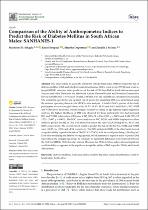| dc.contributor.author | Sekgala, Machoene D. | |
| dc.contributor.author | Sewpaul, Ronel | |
| dc.contributor.author | Opperman, Maretha | |
| dc.date.accessioned | 2022-09-09T11:52:38Z | |
| dc.date.available | 2022-09-09T11:52:38Z | |
| dc.date.issued | 2022 | |
| dc.identifier.citation | Sekgala, M. D. et al. (2022). Comparison of the ability of anthropometric indices to predict the risk of diabetes mellitus in South African males: Sanhanes-1. International Journal of Environmental Research and Public Health, 19(6),3224. https://doi.org/10.3390/ijerph19063224 | en_US |
| dc.identifier.issn | 1660-4601 | |
| dc.identifier.uri | https://doi.org/10.3390/ijerph19063224 | |
| dc.identifier.uri | http://hdl.handle.net/10566/7845 | |
| dc.description.abstract | This study aimed to assess the sensitivity of body mass index (BMI) to predict the risk of
diabetes mellitus (DM) and whether waist circumference (WC), waist-to-hip (WHR) and waist-toheight
(WHtR) ratios are better predictors of the risk of DM than BMI in South African men aged
20 years and older. Data from the first South African National Health and Nutrition Examination
Survey (SANHANES-1) were used. Overall, 1405 men who had valid HbA1c outcomes were included.
The sensitivity, specificity, and optimal cut-off points for predicting DM were determined using
the receiver operating characteristic (ROC) curve analysis. A total of 34.6% percent of the study
participants were overweight/obese, while 10.5%, 10.4%, 36.6% and 61.0% had HbA1c, WC, WHR
and WHtR above the normal reference ranges, respectively. | en_US |
| dc.language.iso | en | en_US |
| dc.publisher | MDPI | en_US |
| dc.subject | Diabetes mellitus | en_US |
| dc.subject | Body mass index (BMI) | en_US |
| dc.subject | South Africa | en_US |
| dc.subject | Public health | en_US |
| dc.subject | Nutrition | en_US |
| dc.title | Comparison of the ability of anthropometric indices to predict the risk of diabetes mellitus in South African males: Sanhanes-1 | en_US |
| dc.type | Article | en_US |

